Elders, Pormpuraaw (Western Cape York Peninsula)
|
Q. Why are crocs important to your community?
A. We have a crocodile dreaming. We have stories, songs and dance about the croc. Long ago, in the Dreaming, our croc ancestor made parts of this land. That was when animals could become people and had many adventures. Our croc story tells about our country near Edward River and its spirits. |
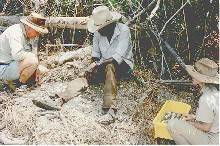
Aboriginal Elder and ranger collect croc
eggs from a nest at Pormpuraaw |
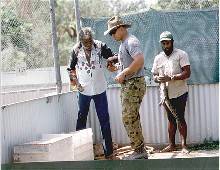
Packing crocs at
Pormpuraaw croc farm |
Q. How do you look after crocs?
A. The croc is our totem. He cannot be hunted, he must be respected. This is protection. For thousands of years, our people have followed this Aboriginal Law. We know this land. Looking after crocs means looking after our country, just like our ancestors did. Today we look after crocs whitefella-way as well. We have a croc farm.
|
video clips
- crocs role in Indigenous culture (including vision of croc feeding and close ups) (47 secs, 344 K) view
- historical vision of croc hunting, hanging up carcass, and sorting skins (42 secs, 308 K) view
- Close call! (24 secs, 180 K) view
|
|
Bryan Peach, ex-croc hunter, Cairns
Q. Why did people start shooting crocs?
|
A. In the late 1800s stockmen shot crocs to protect their cattle. Croc skins were probably first sold in the 1940s. Men went on croc hunting and fishing safaris with land rovers and boats. They wanted adventure more than the money.
Q. What was the life of a hunter like?
A. Croc hunting became a business in the 1950s and 1960s when there was good money in skins. We sold skins to England, France and Singapore. You met some amazing characters in the bush in those days. It was 40 years ago now and things have changed a lot. There wasn't enough money in skins in the 70s so most of us stopped hunting, even before it was banned. |
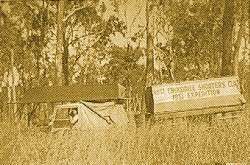
Croc Shooters Club, 1951
Photo: Lloyd Grigg |
Mark Read, croc researcher, Townsville
Q.Mark, why are crocs protected?
A. From the 1940s many crocs were killed for their skins. Croc hunting was not controlled. In fact, crocs all around the world were in trouble. In 1974, hunting in Queensland was made illegal. This law was made to protect estuarine crocs in the wild.
|
Q.You have studied crocs all over the Cape and Gulf. What have you learned?
A. Croc populations of northern Cape York increased after the hunting stopped. They live in the rivers, creeks and wetlands. South of Cooktown, there is less than one croc every 10km. Generally croc numbers seem to be steady. They may even be decreasing south of Port Douglas.
Q. Are crocs threatened today?
A. They are still `vulnerable'. Many croc eggs are drowned when nests near the river are flooded. Only 2 or 3 out of about 500 eggs will grow into adult crocs. They are eaten by goannas and feral pigs. Humans also threaten crocs. Many crocs drown in nets. Much of their habitat is lost when land is cleared for grazing, farming or building. |
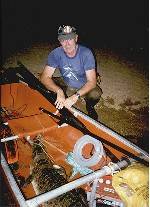
Spotlighting at night for crocs
helps rangers to understand
crocodile numbers and distribution. |
Clayton Enoch, Wildlife Ranger, Cairns
Q. Clayton, how do you know where crocodiles are?
A. We listen to what people like fishermen and the old people tell us. We survey the creeks and rivers at night. We look for the croc's red eye-shine with spotlights. Crocs are usually sitting on the river bank or in shallow water. We can get close enough to estimate their length. Males can be 4.6m to 5.2m maximum length. Females can be 3.1m to 3.4m maximum length.
|
Q. How do you remove a croc?
A. We go out at night in a small boat to harpoon the croc. The harpoon is aimed into the side of the croc's neck. Then the croc is played on the line. This can take up to 4 hours before he gets tired. He is hauled in and strapped to a board so he can't move. Then he can be taken to a croc farm or remote National Park.
Q. What if you can't catch the croc?
A. We can't harpoon a croc that is over 3.6m long or is very shy. We can't get close enough. We have to set traps instead.
A trap is a net with a steel gate. It is tied between the mangroves. The croc goes into the trap to take the bait. Feral pig is good bait. The gate then closes and locks the croc inside. |
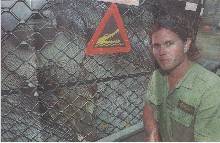
NABBED: Clayton Enoch with
a crocodile removed from a
creek near Mossman.
(courtesy Cairns Post)
|
|